2.
GHANA
Wood product exports during the first half year of 2011
Wood product exports for the first six months of 2011
amounted to 183,350cu.m, (down 9%) valued at Euro 60
million, down 12% compared to levels in the same period
in 2010.
The export of air dry sawnwood, mouldings, and plywood
accounted for 26.4%, 33.7% and 17.4% respectively of
exports or 77.5% of total wood export for the period.
Exports of air dry sawnwood increased by 21.5% in
volume and by 1.4% in value, but this was the exception
as exports of moulding and plywood declined in terms of
both volume and value.
Export of sawnwood and plywood to neighbouring
countries accounted for 53% and 97% respectively of the
total volume of wood products exported during the
period.
Ghana¡¯s export of wood products was largely to Africa,
Europe, Asia, and the Middle East. Ceiba, Wawa,
plantation Teak, Ofram and Denya were among some of
the leading species exported.
The US, Germany, India, Senegal, Belgium, Lebanon,
Egypt amongst others were some of the countries that
imported wood products from Ghana during first half of
the year.
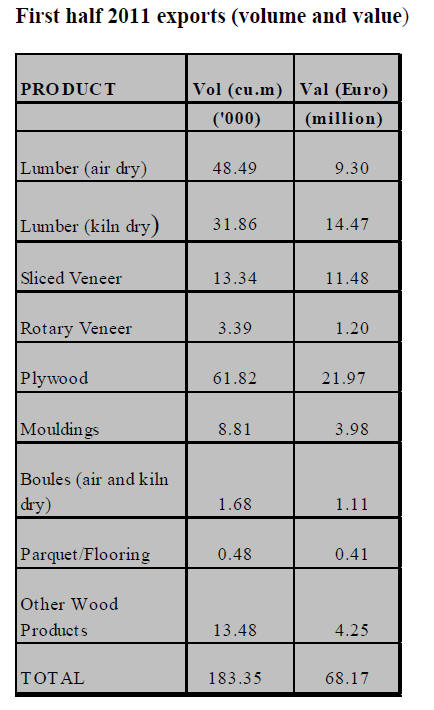
Transparency in distribution of royalty income
The Deputy Minister for Lands and Natural Resources has
called for greater transparency in the procedures for
distributing royalties paid to government for the extraction
of natural resources. He said the government is fine-tuning
its policy guidelines.
Mr. Kamel, the Deputy Minister is also Member of
Parliament for Buem in the Volta Region said government
will review the distribution of royalties and intends to
publish the decisions to provide transparency.
Currently, royalties are proportioned with 55% per cent
going to the Metropolitan Administration and Municipal
and District Assemblies, 25% to Stools and 20% to the
traditional areas.
Utility costs increased from September
Ghanaian consumers are now paying 7% more for
electricity and almost 7% more for water as rates were
increased on 1st September.
The latest increases were announced by the Public Utilities
Regulatory Commission who said that these changes are in
line with the periodic adjustment of tariffs when core
factors influencing production costs change.
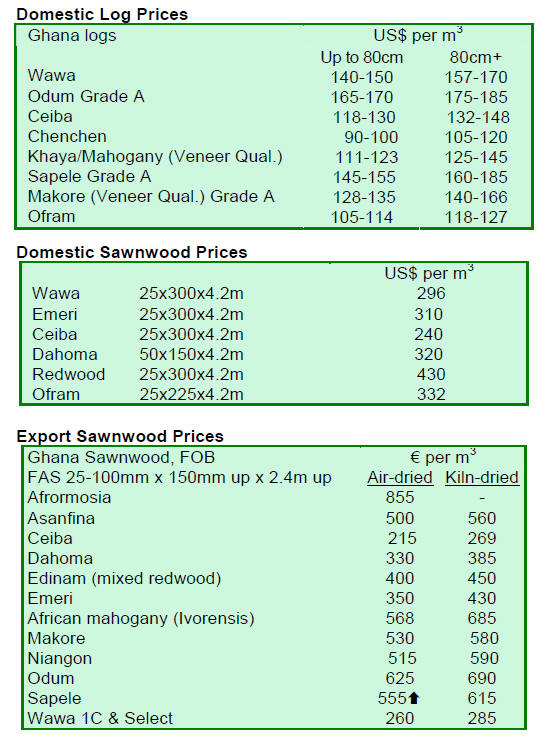
3.
MALAYSIA
Malaysia participates in Cologne-based garden furniture
show
The Malaysian Timber Council (MTC) participated in
SPOGA, the Cologne-based garden furniture trade show
from September 4 to 6, 2011. The Malaysian stand
displayed a range of products that included garden, terrace
and balcony furniture and garden decorations. SPOGA is
regarded as the largest trade show of its kind in the world.
Exports of furniture and other wood products fall
For the first 5 months of 2011 Malaysia¡¯s exports of
wooden furniture and other wood products amounted to
Euro 201.65, a decline of around 6% compared to the
same period in 2010.
The US continues to be an important market for Malaysian
wood products, importing wooden furniture and timber
products worth Euro 50.46 million in the first 5 months of
2011. This, however, represented a decline of 24%
compared to the same period last year.
Other major export destinations for Malaysian wood
products are Australia, Canada, France, Germany, Japan,
Saudi Arabia, Singapore, UAE and the UK.
German government develops initiative to address
illegal harvesting
The German government is working to address the global
problem of trade in illegally harvested timber. As part of
this initiative German authorities are working with tropical
timber exporting countries in an effort to find solutions to
this problem.
The German government has reportedly enacted a new law
which, in English, translates approximately to ¡®Timber
Trade Safeguard Law¡¯. This is just one step taken by the
German government to combat trade in illegal harvested
timber globally. Reports indicate that this legislation will
come into force in 2013.
Peninsular Malaysia may opt to sign the VPA before
Sarawak and Sabah
Malaysia is currently negotiating a Voluntary Partnership
Agreement (VPA) with the EU.
Analysts are speculating that the VPA with Malaysia may
eventually be covering three separate regions. Peninsular
Malaysia may opt to sign the VPA before Sarawak and
Sabah. These two states in East Malaysia may then
separately sign VPA¡¯s with the EU at a later date.
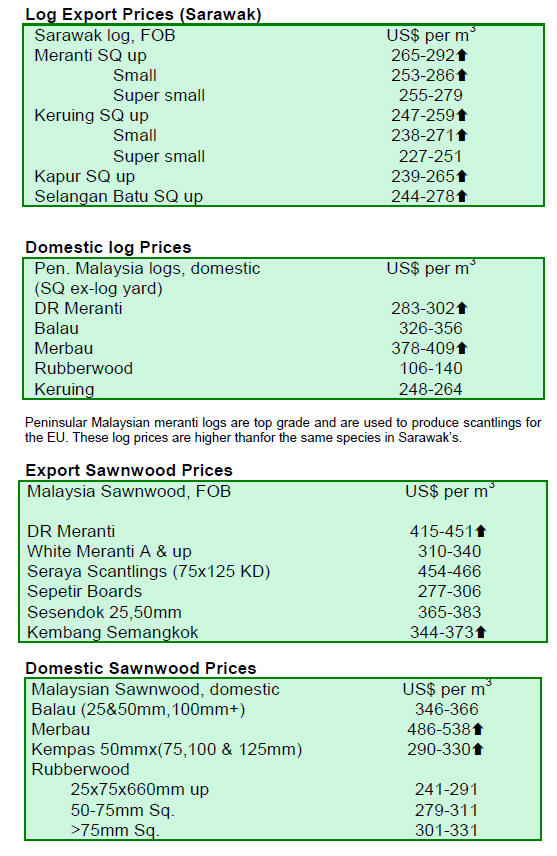
4.
INDONESIA
Indonesian wooden furniture
moving upmarket in Australia
Indonesian wooden furniture is moving upmarket in
Australia with the opening of the Discount House Direct
(DHD) in the central business district of Lismore, New
South Wales.
The new store will feature a wide range of hand-made
Balinese wooden furniture from dinning tables to display
cases and living room furniture. DHD will be opening its
store at end September 2011.
Indonesian company exhibited at the International
Casual Furniture and Accessories Market, Chicago
Marie Albert Furniture, which owns and manages wooden
furniture manufacturing plants in Indonesia, will be
exhibiting its wooden furniture for the first time at the
International Casual Furniture and Accessories Market.
The International Casual Furniture and Accessories
Market was running from 12th September in Chicago
USA.
This show attracted furniture and furnishings
retailers,
interior designers, interior decorators, architects and
product specifiers, The 2011 market featured more than
500 manufacturers, wholesalers and designers exhibiting
in a 35,000 square metre exhibition venue.
Marie Albert Furniture exhibited a wide range of
allweather
rattan and teak outdoor patio furniture from
Indonesia.
Indonesian wooden furniture reaches the shores of
Jamaica
Indonesian wooden furniture is on display in Jamaica
thanks to the efforts of Living Spaces, a specialist
furniture boutique. The company offers furniture and
furnishings from Indonesia and other countries, including
India, Italy, the US and from domestic manufacturers.
Living Spaces began business about 10 years ago and has
attracted a very varied customer base.
IFFINA sets March 14 2012 for opening of Craft Fair
The International Furniture and Craft Fair Indonesia
(IFFINA) has announced that its next fair will be held
from March 11 to March 14, 2012 at the Jakarta
International Expo (JIE) Kemayoran, Jakarta.
IFFINA 2012 is organized by Radyatama (an exhibition
organizer) and the Indonesia Furniture Industry and
Handicraft Association (Asmindo). The website for
IFFINA 2012 is: http://www.iffinaindonesia.
com/2012/content.php?mid=2
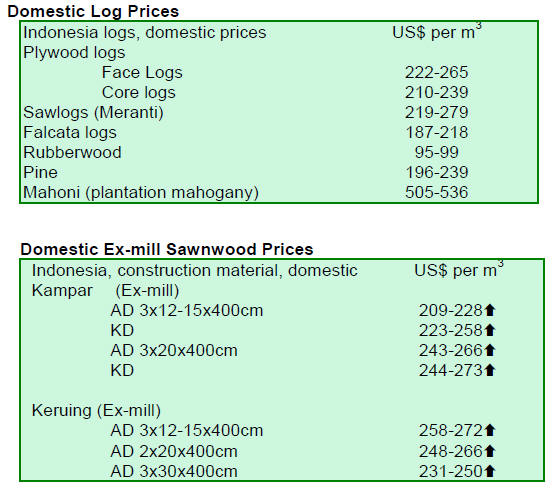
5. MYANMAR
Tax reduction for value-added wood and
forest products
The Myanmar government has now included added value
wood, bamboo and rattan products to the list of products to
which reduced taxes apply. This change in tax levels for
wood, bamboo and rattan products came into effect as of
the 1 September 2011 and will continue until to 14
February 2012.
Upcountry sale of un-graded Teak logs
On the 5th of September 2011 the Myanma Timber
Enterprise(MTE) held a Special Open Tender for Ungraded
Teak logs in Yangon.
Out of the total quantity of 1670 hoppus tons
available,
288 h.tons were sold to buyers in Thailand, 47 h.tons to
Singapore and 1,335 h.tons to domestic buyers. The logs
on sale were the stock remaining from previous tender
sales.
The average price received was Euro 557 per h.ton
FOB
Yangon (approx US$802). Prices for SG-8 and SG-9 were
US$871 and US$800 per h.ton FOB Yangon respectively.
Participation by foreign buyers was not very
enthusiastic
as these logs were stored in the various depots of the West
Katha Extraction and Mandalay Rafting Agency of the
MTE, far from Yangon.
The successful bidders are responsible for
transporting the
logs to Yangon for shipment initially at their own expense.
The costs incurred by the buyer in bringing the logs to
Yangon will be reimbursed later by MTE at prescribed
rates.
Raw material for the local industry
There are reports that MTE may provide logs to the local
timber industry through open tenders. These logs would
have to be processed inside the country and should not be
exported. Through this the MTE hopes to reinvigorate the
industry which is currently struggling to remain
competitive.
Market Outlook
There were some changes in market sentiment over the
past two weeks. Demand for Teak has slowed somewhat,
say analysts. This commonly happens during the holiday
period in Europe.
High quality high-end teak products, unlike other
wood
products from Myanmar are mainly for consumers in
Europe and USA. Analysts say that demand for teak often
experiences these ups and downs but that the product is
just too good for demand to permanently weaken.
Pyinkado demand is still weak but the demand for
Kanyin
(Gurjan) is firm.
Expanded role for the newly created Ministry of
Environmental Conservation and Forestry
The Voice Weekly, a privately published vernacular
journal in Myanmar, has reported the comments of various
forest and conservation experts welcoming the enhanced
role of the newly created Ministry of Environmental
Conservation and Forestry.
Various NGO¡¯s active in forestry and environmental
matters in Myanmar, commented that including
environmental affairs at a ministerial level was long over
due.
The journal also mentioned that the functions of the
new
ministry would necessarily involve other ministries such
as the Ministry of Irrigation and the Ministry of Mining
and that this would require coordination between the
various government departments.
Most people directly or indirectly involved in the
timber
sector in the country feel that the new mandate of the
ministry to address Myanmar¡¯s commitment to the
environment and in recognising the importance of its
forests is a positive change.
Analysts note the daunting task ahead for the newly
formed ministry because of diverse interests in the sector.
Most challenging will be how to balance meeting the
domestic timber requirements for an ever increasing
population and meeting targets for increased timber
exports.
FREDA laments depletion of teak and pyinkado in
Myanmar¡¯s forests
During the past twenty years Myanmar¡¯s forests have been
depleted of high value timbers significantly according to
the Vice Chairman of FREDA.
This, says FREDA, is apparent as the availability of
high
value timbers has dropped and average log grades have
became lower.
According to 1990 estimates, the availability of
teak was
241.91 million cubic metres and that this comprised
around 8% of the forest stock. During 2000 and 2010 the
statistics showed a decline to 149 million cubic metres or
only 5% of the standing stock.
Studies on Pyinkado quoted by FREDA suggest that in
1990 the availability was 285 million cubic metres or 10%
of the forest stock. In 2010 this had fallen to 47 million
cubic metres and the stock had fallen to 1.6%.
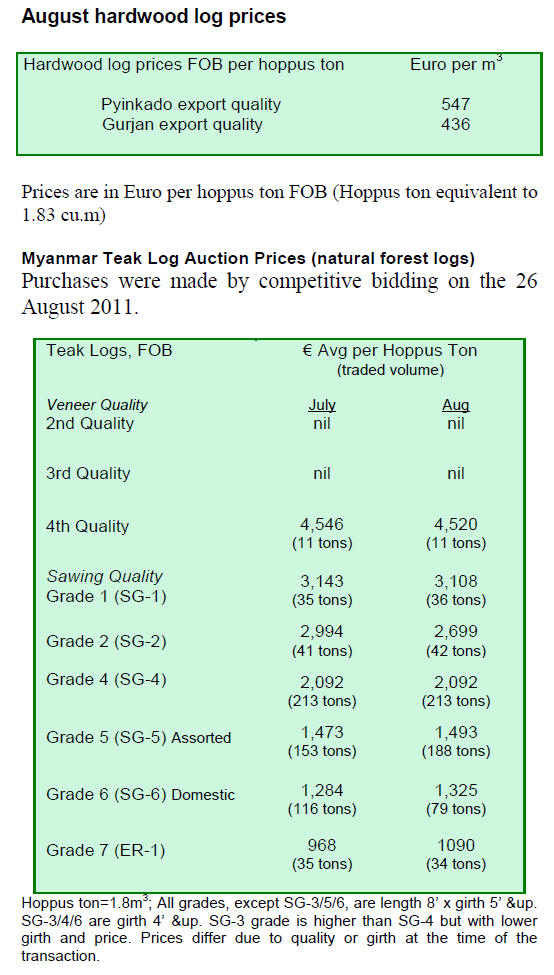
6. INDIA
Critical log shortage affecting panel
industries
A chronic problem of raw material shortages for wood
based panel industries has resulted in many plants having
to run well below capacity. A two pronged strategy is
being proposed to bridge the gap between demand and
supply of industrial raw material.
The first focuses on the development of appropriate
technologies for more efficient utilization of available
resources and the second on exploring the options for
companies to quickly establish plantations of fast growing
species suitable for use in the wood-based panel industry.
Options being considered by the composite board
sector
include greater use of non-wood renewable fibres in the
manufacturing process such as bamboo and agro-residues
like such as bagasse, coir, rice husks and jute, wheat and
rice straw.
Level of teak imports being maintained
Shipments of teak logs arriving at ports in India are
reportedly satisfactory and are at levels which match
demand in the markets for teak, particularly in and around
Mumbai and Kandla.
Mining sector expansion held up by disputes with
forestry authorities and forest communities
The recent decline in India¡¯s GDP is, in part, the result of
a slowing in expansion of the mining sector say analysts.
For some time now disputes have continued between
the
Ministry of Environment and Forests and the Ministries of
Industries and Mining over the opening of new mines.
Several steel and aluminium plant projects have not
come
on stream because the mine areas are heavily forested and
the forest communities in these areas are strongly opposed
to large scale mining activity. Resolving these multiple
conflicts presents a challenge and ways to reach an
amicable solution are being pursued.
Indian builders search for new business model in
face
of falling sales
Indian builders across the country are beginning to
cooperate with each other in order to stay in business.
Falling home sales, increasing housing stocks (reportedly
over 36 months in some areas) and rising interest rates
have prompted builders to begin cooperate to lower
overheads and cope with slow sales.
Some are working on joint projects, even to the
extent that
they share marketing skills as well as on-site skills and, in
other cases, land and capital. Cooperation between
landowners and builders is a recent innovation in the
Indian building sector because large areas of suitable
building land are difficult to find.
Rupee drops on dollar purchases by importers
India's rupee dropped to the lowest level against the US
dollar this year as commodity and gold importers
increased dollar purchases. The rupee fell over four days
recently after oil prices rose to almost US$90 a barrel.
Analysts anticipate that, as usually happens, the
domestic
market for gold jewellery will rise during period of
Diwali (festival of light) which falls in October.
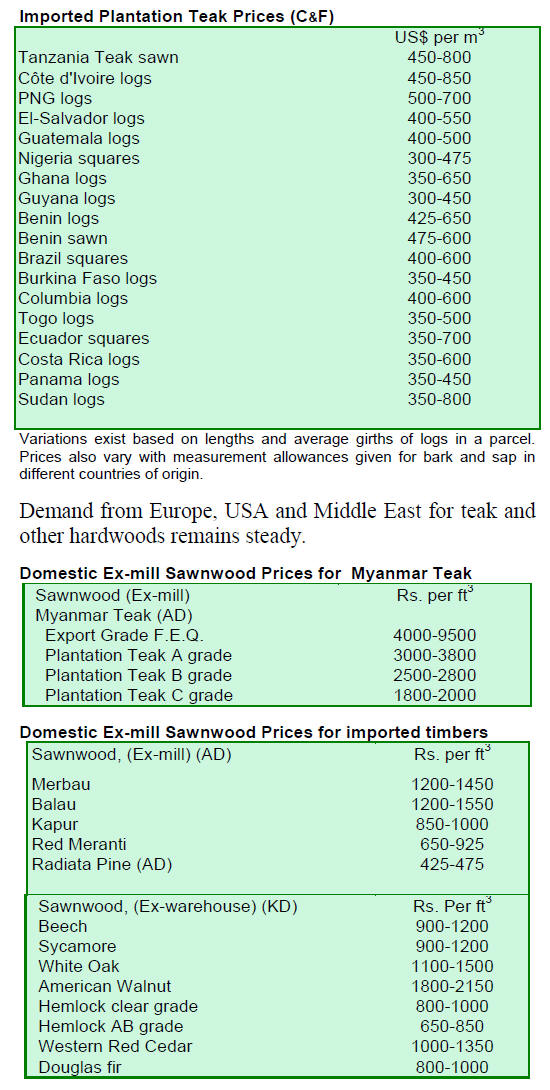
7. BRAZIL
Mato Grosso reinforces staff to
assess and approve SFM plans
The Environment Secretary of Mato Grosso has decided to
allocate additional professionals to analyze and approve
sustainable forest management (SFM) plans submitted by
industry in the state.
This decision, say analysts, was taken to overcome
the
disruption caused by a strike by SEMA employees and to
guarantee that the management plans that have been
submitted by industry are promptly assessed.
However, media reports claim that forest product
companies in Mato Grosso believe that it will take time
for the new task force to become fully operational.
The industry says the prompt assessment of
management
plans is essential if companies are to harvest sufficient
logs to get them through the rain season which is about to
begin. Many mills are facing log shortages and production
and sales over the next few months are expected to fall.
Analysts report that the local industry estimates
that the
strike and the subsequent delay in approval of
management plans has negatively affected regional
production and the opportunity to conclude up to BRL 57
million in sales.
Timber and furniture industries to profit from
2014
events in Brazil
The football World Cup, which will be held in Brazil in
2014, is expected to create significant opportunities in the
domestic market for small sized wood and furniture
companies.
This was the conclusion of a recent report
'Opportunities
for Micro and Small Businesses in the World Cup Host
Cities".
This report was based on a survey carried out by
SEBRAE
(Brazilian Service to Support Micro and Small
Enterprises) in partnership with the Getulio Vargas
Foundation (FGV).
The survey and report are just two of the
activities
undertaken in the ¡®2014 SEBRAE Program¡¯ which will
involve expenditure of around US$80 million for all its
activities up until the end of 2013. These funds will be
committed to services in consulting, industry innovation
and market access programmes.
According to the recent report, job opportunities
in the
small and medium sized wood and furniture companies
will increase.
The SEBRAE programme will also offer support in
consulting and technology related to production processes,
streamlining production, operational training and quality
control.
2011 Brazil Furniture Fair delivers positive results
Organisers of the 2011 Brazil Furniture Fair reached say it
reached its objective of bringing together the national
furniture sector, encouraging business development and
promoting exports.
The 2011 fair attracted 128 exhibitors from various
furniture producing areas in the country and over 20,000,
mainly professional, visitors from all over Brazil. In
addition, visitors from 28 different countries also attended
the event.
In two days of arranged business meetings through
the
¡®Buyer Project - 2011 Brazil Furniture¡¯, furniture
manufacturers estimate that up 60-70% of the 150
meetings that took place will likely generate business
deals.
The Buyer Project was introduced by the organizers
of the
fair with support of the Brazilian Export and Investment
Promotion Agency (APEX-Brazil).
Para timber exports falling due to appreciating
Real
and delays in management plan approvals
Exports of tropical plywood from the northern Amazonian
state of Para fell significantly between January and August
this year compared to the same period of last year.
In volume terms the decline was 61%, while the
reduction
in terms of value reached 56%, from 17,900 cu.m in 2010
to 6,900 cu.m in 2011 and from US$ 10.4 million to US$
4.6 million.
For tropical sawnwood the decline in exports was
not as
marked as for plywood. In the first eight months of 2011
the drop in export volumes was in the region of 17% (from
154,500 cu.m to 127,600 cu.m) while the decline in export
earnings fell 7% (US$75.5 million to US$70.5 million).
The timber industries in Para have suffered from
delays in
the approval of forest management plans. Furthermore, the
continuous appreciation of the Brazilian currency against
the US dollar has also negatively impacted wood product
exports.
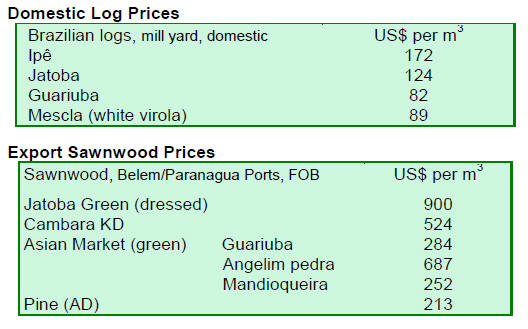

8. PERU
Poor export performance prompts
policy development
to promote the timber sector
News is circulating suggesting the government will adopt
new policies to promote the timber industry given the poor
export performance of the sector.
Timber exports in the first half of the year were
down 15%
to US$ 71.2 million compared to US$83.6 million in the
same period in 2010.
The National Director of Industries in the Ministry
of
Production, Ernesto Lopez, said the timber industry has an
enormous potential for growth and investment could
generate job opportunities in rural and remote areas of the
country.
Forest development supports social inclusion
For progress to be achieved in the forestry sector there
must be social inclusiveness and attention to the
environmental integrity of the natural forest as well as
incentives for the private sector to invest, according to the
president of the Association of Exporters (ADEX).
This, says the association, requires the
coordinated action
of the government and private enterprises to add value to
the permanent production forests and reverse the decline
in output and exports of wood products.
In 2010 timber exports totalled US$ 171.8 million,
11%
higher than in 2009 but 22% lower than the figure for
2008.
The president of ADEX projected that, for 2011,
export
shipments would be close to 20% more than last year but
still well below the level in 2008.
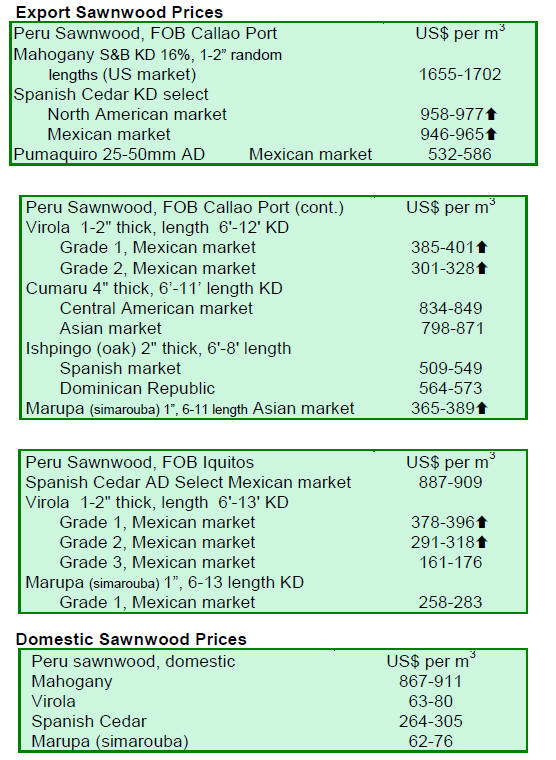
9.
GUYANA
Greenheart and Purpleheart
log export performance
During the two weeks under review there were no exports
of Greenheart logs. Purpleheart logs were exported and
price levels were essentially unchanged.
Standard sawmill quality Purpleheart log prices
maintained the levels that were achieved during the last
shipments. However, prices for Purpleheart fair and
standard sawmill quality logs were higher.
Mora logs prices remained stable and the minimum
price
received was the same as previously reported.
Undressed sawnwood attracts improved prices but
not
dressed sawnwood
Only two qualities of Undressed Greenheart sawnwood
were exported in the period under review namely; select
and merchantable.
Undressed Greenheart (select) prices increased at
the top
end of the range from US$806 to US$827 per cubic metre.
Merchantable quality Undressed Greenheart attracted a
price of US$530 per cubic metre on the export market.
Undressed Purpleheart (Select) recorded a
significant
increase in top-end price for this period moving from
US$1,018 to US$1,548 per cubic metre, making this one
of the highest prices ever received for Purpleheart
sawnwood of this quality.
Undressed Purpleheart (Sound quality) also
attracted
better prices and was traded at US$575 per cubic metre.
Prices for Undressed Mora (select and merchantable)
remain firm at levels reported in the previous report.
Prices for Dressed Greenheart experienced a dip in
its
upper end price from US$975 to US$933 per cubic metre
during the period under review.
On the other hand, Dressed Purpleheart sawnwood
enjoyed favourable prices on the export market reaching a
high of US$1,200 per cubic metre in comparison to price
levels in the previous period of US$890 per cubic metre.
Guyana¡¯s Washiba (Ipe) continues to attract very
favourable prices
Roundwood export prices for Piles and Posts for the two
week period under review increased trend for all product
categories. Similarly, Splitwood received attractive prices
on the export market, reaching as high as US$ 1,254 per
cubic metre.
Washiba (Ipe) one of Guyana¡¯s highly demanded
species
continues to attract favourable prices on the export market,
the latest price was US$2,500 per cubic metre.
Mechanism for dialogue between loggers,
sawmillers
and end-users established
The Forest Products Development and Marketing Council
of Guyana Inc. (FPDMC), the Guyana Forestry
Commission (GFC) and Government of Guyana recently
organised a workshop, the main purpose of which was to
get stakeholders to interact and share ideas and concerns
on the potential impact of the unavailability of sawnwood
in the local market and on greater utilization of lesser used
species (LUS).
In addressing the stakeholders forum the Hon.
Minister
Robert Persaud spoke about challenges faced by the forest
industry with respect to evaluating domestic demand so
concessionaires can plan production. It was noted that it is
now becoming more difficult to meet demand for the main
commercial species and that there is need to utilise more
LUS.
Efforts needed to raise public awareness of the
LUS
and to develop building codes
The stakeholder session concluded that, in order to
increase the use of the LUS, efforts should be directed to
raising public awareness of the LUS through
comprehensive media advertising and education
programmes as well as training for stakeholders.
Further, the meeting suggested that the public
awareness
activities should be linked with efforts by the government
to promote and provide practical demonstrations of the
uses of the LUS.
It was also strongly recommended that there is a
need for a
building code. Such a code should incorporate safety
standards and other legal requirements as well as
addressing the issue of standardisation of dimensions of
sawnwood.
Another key issue highlighted at this workshop was
that
there should be more training within the industry so as to
improve the efficiency of forest operations.
Guyana log export policy currently being
reviewed
The Guyana Forestry Commission on behalf of the
Government of Guyana has indicated that the National log
export policy is currently being reviewed for
implementation in 2012. This, says the GFC, will
necessitate a national consultation process to discuss limits
on log exports and the ways to encourage more downstream
processing.

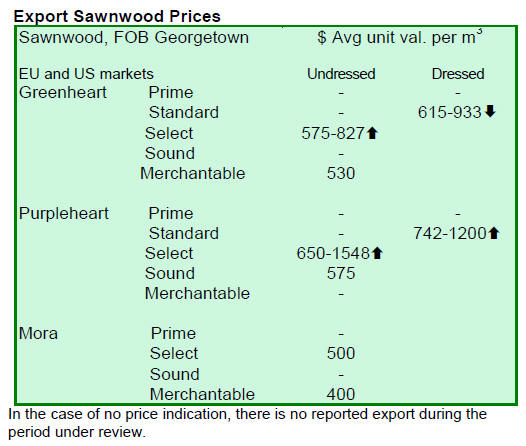
¡¡
Related News: